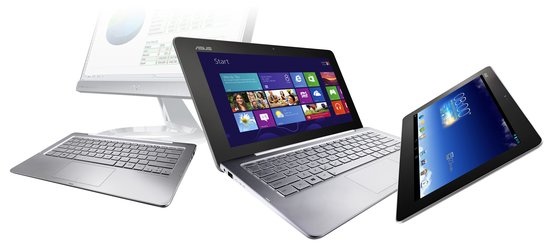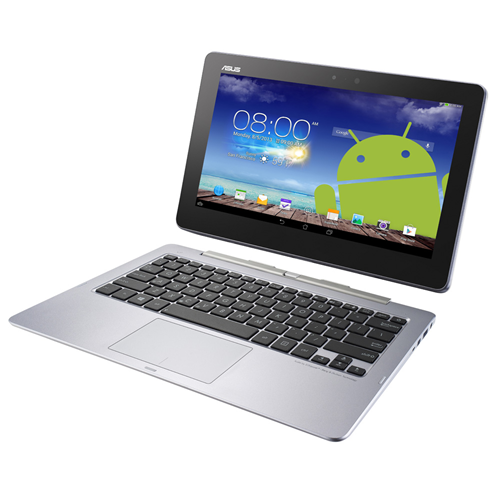REVIEW: ASUS Transformer Book Trio

The PC market has been on the wane for quite some time despite the industry’s efforts to tempt consumers with convertible notebooks and Windows 8 tablets.
The popularity of Android tablets and iPads in additon to longer upgrade cycles has played a part in the downturn.
Now, in an attempt to revive the market, PC manufacturers and chipmakers are getting behind a new push: devices that run both Windows 8 and Android.
The movement began at this year’s Consumer Electronics Show (CES) with both Intel and AMD confirming support for the feature at the chip level. Intel coined the feature “Dual OS”, while AMD announced a partnership with BlueStacks to run full-screen and windowed Android apps within Windows itself.
Several manufacturers at the show demonstrated notebooks with detachable screens that seamlessly switched between the two divergent operating systems at the press of a button.
Asus, however, has beaten most of its rivals to the market with the Asus Transformer Book Trio. Billed as the “world’s first Three-in-One Ultraportable”, the Asus Transformer offers a two-part dockable design that can be used by one person as a laptop or by two people as a separate Android tablet and Windows desktop PC.
It all sounds promising on paper but how does it actually perform?

Solid but hefty design
At a hefty 1.7kg and almost 25mm thick with the lid closed shut, calling the Asus Transformer Book Trio an Ultrabook is somewhat of a stretch. It’s a concession that the company clearly had to make in order to accommodate all of the internals.
The keyboard base, or what Asus refers to as the “PC Station”, packs an Intel Core i5 processor, 4GB of RAM, 500GB hard drive and a 33Wh battery. The display, which runs Android when detached from the base, houses an Intel Atom Z2560 (1.6GHz) processor, 2GB of RAM, 16GB of on-board storage and a 19Wh battery.
The display is an intensely bright 11.6-inch 1920 x 1080 IPS panel and despite the ridiculously large bezels we had very few qualms with the screen. However, the contrast ratio could be better and the black levels fall noticeably short with movies and games, lacking a level of depth that we are used to seeing on the latest Macbook Pro or the Acer Aspire R7.
The exterior consists of a silver metal construction with a brushed aluminium finish and while it’s far from a svelte design, it feels sturdy in the hand. Similarly, the hinge connecting the tablet to the keyboard is well built, with an assured click every time the connection is made.
Keyboard-trackpad combo a real worry
The keyboard, on the other hand, feels cheap. The keys have too much travel for our liking and there’s no backlighting whatsoever. The keys are a tad too small which leads to frequent typing errors. Other oddities include the placement of the power button which is precariously close to the backspace key.
The trackpad, which is often a source of frustration on Windows notebooks, is also a real mess. It senses taps and swipes that don’t occur while at other times it becomes completely unresponsive. It also failed to respond to any gestures such as the one finger swipe to switch between open applications during testing.
The speakers are also disappointing. Dialogue sounds as though it’s rattling portions of the chassis and distortion is evident even at moderate volumes.
Is the tablet any good?
Unplugging the tablet from its keyboard base and using the display solely as an Android tablet is a mixed bag.
The super-sized tablet weighs 700 grams which is a lot in the tablet world. To put it in context, the tablet weighs 50 per cent more than the iPad Air. The result is a device that is uncomfortable to hold for any extended period of time. The large 11.6-inch display also means that the device can be rather awkward to hold in the hand.
The tablet runs Android version 4.2.2 and is generally snappy and responsive while browsing the web, switching between applications and navigating menus. However, it does struggle with more demanding applications such as 3D games with occasional frame-rate dips.
Asus opted for the older Intel Atom dual core chips instead of the new Bay Trail quad core processors, thus missing out on the additional horsepower and power efficiency gains that the newer chips would have provided.
It’s also worth noting that those apps yet to be optimised for Intel’s Atom processors will not install on the device.
A few too many compromises
A key feature of the Trio is the ability to run Windows 8 independently by plugging the keyboard base/PC Station into an external monitor while a second person continues to use the display as an Android tablet. Of course this also means that each device loses the ability to switch between the two operating systems until the tablet and PC Station are reconnected.
Unfortunately, the battery life of the tablet is well below average, clocking in at a little over four hours compared to the 10-plus hours we are used to seeing on the iPad and Samsung Galaxy Note 10.1.
The tablet can be plugged into the keyboard base, which doubles the battery life to eight hours. Having access to the keyboard while using Android is convenient for typing out long emails and documents but most will want to switch to Windows to get some real work done.
Thankfully, jumping to Windows 8 is almost instantaneous using the dedicated OS switcher button. The OS state is saved so you can safely bounce between the two operating systems and pick up where you left off. Files can also be shared between the two devices using the included PC Tool software.
Processor intensive tasks such as video encoding and image editing are on par with other Intel Core i5 powered Ultrabooks such as the Sony Vaio Pro 13. The onboard HD 4400 graphics also does a decent job of running multiple monitors and light gaming.
Asus’ decision to employ a 500GB rotating hard drive instead of a faster SSD drive means that boot-up times and resuming from standby are a frustratingly long experience, taking upwards of 30 seconds. It’s a far cry from the 10- to 12-second boot up time that we are using to seeing with most modern Ultrabooks. The four-hour battery life also falls well short of other Haswell-powered Windows Ultrabooks on the market.
Ultimately, the Asus Transformer Book Trio is jack of all trades device with a few too many compromises.
While the transition between Windows and Android is seamless, the reality is that there are much better performing Android tablets and Windows Ultrabooks available on the market. Given the $1599 price tag, you are better off buying a Windows Ultrabook and an Android tablet separately.
Krishan Sharma is a Brisbane-based freelance journalist and writes for a number of different publications covering business IT and consumer technology.
















